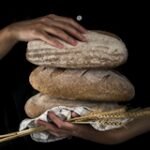While we don’t have any ancient recipes in the sense of actual written formulas left to us by early bakers, we can make some educated guesses about how bread might have been made in ancient times. Here’s an approximation of a simple, ancient-style sourdough bread, using just flour, water, and salt:
Ancient Sourdough Bread Recipe
Looking for a different sourdough bread recipe? This is an ancient style sourdough bread.
Servings 1 loaf
Calories 150kcal
Ingredients
- 500 grams of whole grain flour Emmer, Einkorn, or Spelt
- 350 grams of water
- 10 grams of salt
- 150 grams of active sourdough starter
Instructions
- Mix the Dough: Combine the flour, water, and sourdough starter in a large bowl. Mix until no dry flour remains. Cover and let it rest for 30 minutes. This is your autolyse phase.
- Add Salt: Add the salt to the dough and knead it until the salt is fully incorporated.
- Bulk Fermentation: Let the dough rise in a warm place for about 4 to 6 hours, or until it has roughly doubled in size. The dough should be bubbly and light.
- Shape the Dough: After the dough has risen, gently turn it onto a lightly floured surface. Fold the dough onto itself, turning and folding, until it forms a tight ball. This creates tension on the surface of the dough which will help it hold its shape during the final rise.
- Final Proof: Place the shaped dough into a floured banneton (bread basket) or a bowl lined with a floured towel, cover it, and let it rise for another 2 to 4 hours, or until it passes the poke test (when a gently indented finger poke springs back slowly, but leaves a visible indent).
- Bake the Bread: Preheat your oven to 475°F (245°C). If you have a baking stone or Dutch oven, place it in the oven while preheating. Carefully turn the risen loaf onto a piece of parchment paper. Score the top of the loaf with a sharp knife or bread lame. Lower the heat to 450°F (232°C), and bake for 30 minutes with a cover (if using a Dutch oven) and then another 15-20 minutes uncovered, until the bread has a deep golden brown color and sounds hollow when tapped on the bottom.
Notes
This recipe is an approximation of how bread might have been made thousands of years ago, but with the advantage of modern understanding of bread science and temperatures for optimal baking. Remember, sourdough is as much an art as it is a science – each loaf is unique and a reflection of your own personal touch. Enjoy the journey!
